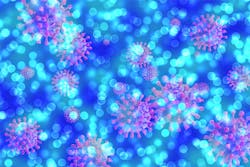Imaging cytometry details lung tissue changes at single-cell level in COVID-19 patients
Using imaging mass cytometry technology from Fluidigm (South San Francisco, CA), researchers at Weill Cornell Medicine (New York, NY) have identified a phenotype of immune cell activity in the lungs of patients infected with SARS-CoV-2, the virus that causes COVID-19, that is distinct from activity observed with other respiratory infections. This phenotype has been identified based on spatial analysis of lung tissue at the single-cell level throughout the disease continuum. The analysis was conducted using Fluidigm’s Hyperion imaging mass cytometry system, which is designed to simplify high-multiplex panel design and eliminate the impact of tissue autofluorescence by using highly pure metal tags for which signals are separated by mass instead of by wavelength.
Imaging mass cytometry enabled the researchers to view not only the structure of the tissue, but also the interplay between infected cells and the immune system in COVID-19 patients, says Olivier Elemento, Ph.D., Director of the Englander Institute for Precision Medicine and Cornell University Professor of Physiology and Biophysics, and lead researcher of the study. “The diverse range of tissue samples offered incredible insight into the mechanisms of disease progression in these patients, and the rich dataset provided our computational biologists with an opportunity to interpret changes in tissue architecture as well as detect and understand patterns that may provide insights into future approaches to therapies,” he adds.
Related: Tumor architecture insights advance cancer diagnosis and treatment
This study utilized the Fluidigm reagents portfolio to label antibodies in a custom-designed panel of 36 biomarkers to capture different immune and stromal compartments of the lung. These antibodies were then used to label lung tissue sections obtained from patients who had died with acute respiratory distress syndrome (ARDS) following influenza, bacterial pneumonia, or COVID-19 respiratory distress syndrome, and also from healthy individuals for whom lung tissue was available.
Samples from COVID-19 patients were categorized as early or late, depending on whether death occurred 16–30 days or 31–44 days after the onset of respiratory symptoms, respectively. The Hyperion imaging system analysis generated 237 highly multiplexed images identified across all specimens.
Key findings of the study include:
- A significant reduction in alveolar lacunar space, increased immune infiltration, and apoptosis-mediated cell death were observed in all diseased samples compared with those from healthy lungs.
- Neutrophil infiltration was increased in ARDS and early COVID-19 compared with normal lung, but appeared to be a hallmark of bacterial pneumonia, while a high degree of inflammation, infiltration of interstitial macrophages, complement activation, and fibrosis was characteristic of COVID-19.
- While late COVID-19 disease specifically displays hallmarks of tissue healing, the high COVID-19 mortality rate suggests that complement-activation-induced damage to the lung in concert with other immunological factors may lead to abnormal blood clotting in the lungs, which can lead to death.
Study findings agree with other recent studies suggesting that a type of pathophysiological response found in patients with ARDS due to influenza or bacterial pneumonia is similar to that found in those with COVID-19. However, in contrast with those studies, the Weill Cornell Medicine findings suggest that the hyperinflammatory phenotype as assessed by cytokine levels in peripheral blood is specific to COVID-19.
These findings suggest that early interventions that reduce off-target immune response or activators of the complement cascade could improve outcomes for COVID-19 patients.
“Understanding the pathology of COVID-19 lung disease is essential for developing interventions and treatment regimens that can improve patient outcomes and reduce mortality,” said Chris Linthwaite, President and CEO of Fluidigm. “This study adds to a growing body of data underscoring the importance of tissue architecture and three-dimensional cell-to-cell interactions in critical biologic and pathophysiologic process.
“Our robust IMC platform is uniquely suited to exploring these interactions with single-cell resolution. Significantly, in this study, IMC analyses uncovered novel interactions and cellular phenotypes that add important new insights into mechanisms of COVID-19 pathology, and these insights may help drive clinical practices that can improve patient outcomes.”
Full details of the work are available through the medRxiv pre-print service.
For more information, please visit fluidigm.com.
Source: Fluidigm Corporation press release – November 19, 2020
